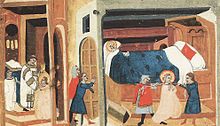Dalimil Chronicle

The Dalimil Chronicle ( Czech Dalimilova kronika ) is the oldest chronicle written in the Czech language . In addition to its importance as a linguistic monument, it is of historical value, especially for the late 13th and early 14th centuries, as it describes the events at the end of the Přemyslid rule from an eyewitness perspective.
Although the name of its author is unknown, it has been commonly referred to as the "Dalimil Chronicle" or "Chronicle of the so-called Dalimil " since the 17th century .
The Chronicle
The rhyming chronicle is divided into 106 chapters. It begins with a short chapter on the Tower of Babel and then describes the history of Bohemia from the first legendary rulers up to the year 1314. Some addenda refer mainly to the years 1315 and 1316. In addition to the Chronica Boemorum , the author used various legends and saints also referred to oral tradition.
The chronicle was created during the reign of King John of Luxembourg and reflects the noble opposition at the time to the “foreign” king and his advisors. The author writes patriotically , as an advocate of the Bohemian nobility and opponent of foreign influences in Bohemia. For example, he is against tournaments , foreign clothing and other “harmful” foreign fashions. His work was therefore mainly disseminated during the national revival movement. The chronicle is one of the most famous works of early Czech literature.
Lore
The Dalimil Chronicle has survived in a large number of complete and incomplete manuscripts and has been reprinted many times since 1620. In addition to the original Czech version, there are also two different German translations - one of which is in prose. In 2005, a previously unknown, illustrated Latin translation appeared in a Paris auction room, now known as the “Parisian Manuscript”. It was probably made around 1330–1340 in northern Italy on behalf of King John of Luxembourg. The manuscript became the property of the Czech state for 339,000 euros.
The handwritten rhyming chronicle of the German revision of Behem lant's Di tutsch kronik is in the Prague Castle archive in the library of the Metropolitan Chapter .
expenditure
- Pavel Ješín von Bezdězí: The old Czech rhyming chronicle of the so-called Dalimil , reprinted with an introduction by Jiří Daňhelka. Sagner, Munich 1981, ISBN 3-87690-213-4 (= Sagner's Slavic collection, Volume 4).
- J. Daňhelka, K. Hádek, B. Havránek, N. Kvítková (eds.): Staročeská kronika tak řečeného Dalimila: vydání textu a veškerého textového materiálu. 2 volumes, Academia, Praha 1988, ISBN 80-7066-591-2 ; Volume 3: Marie Bláhová: Staročeská kronika tak řečeného Dalimila v contextu středověké historiography latinského kulturního okruhu a její pramenná hodnota. Historický komentář. Rejstřík. Academia, Praha 1995, ISBN 80-200-0282-0 (critical edition).
- Václav Hanka : Dalimilova Chronika Česká v nejdávnější čtení navrácena . 1849 ( digitized version of the German edition in the Google book search)
- Josef Jireček (ed.): Rýmovaná kronika česka tak rečeného Dalimila. Di tutsch kronik from Behemlant . In: Fontes rerum Bohemicarum (Volume 3), Prague 1882, pp. 1–293.
- Marie Bláhová (Ed.): Kronika tak řečeného Dalimila . Svoboda, Praha 1977 (rewrite in modern Czech).
literature
- Tomáš Edel: Příběh johanitského komtura řečeného Dalimil . Kapitola z dějin české politiky. Prague 2000, ISV nakladatelství, ISBN 80-85866-61-7 .
- Radko Šťastný: Tajemství jména Dalimil . Melantrich, 1991, ISBN 80-7023-072-X .
- Brom, Vlastimil: The German Dalimil. Investigations into the rhymed German translation of the old Czech Dalimil chronicle. Brno: Masarykova univerzita 2006, ISBN 80-210-4211-7 .
Web links
- Dalimil Chronicle on the Internet (Czech)
- Report on the Paris manuscript ( Memento of July 5, 2007 in the Internet Archive ) (Czech)
- Research project: The German rhyming translation of the Old Czech Chronicle of the so-called Dalimil in the context of the Czech, Latin and German text tradition - linguistic, literary and historical analysis
- Dalimil Chronicle at LitDok East Central Europe / Herder Institute (Marburg)